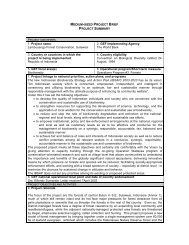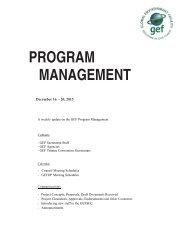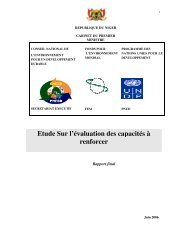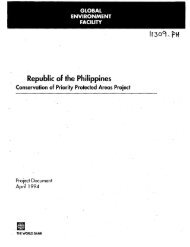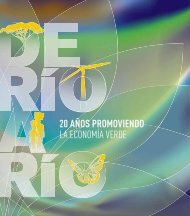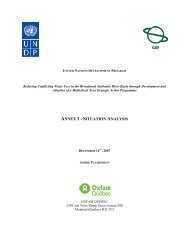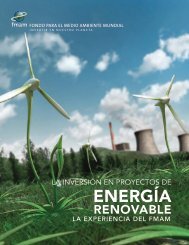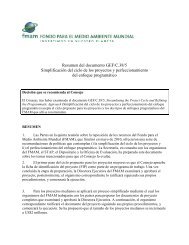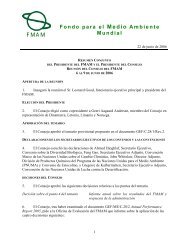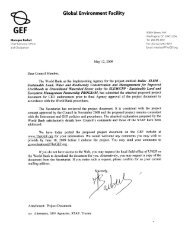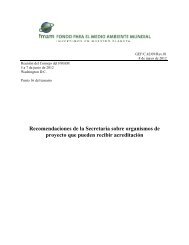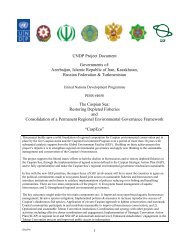English - Global Environment Facility
English - Global Environment Facility
English - Global Environment Facility
Create successful ePaper yourself
Turn your PDF publications into a flip-book with our unique Google optimized e-Paper software.
- 11 -<br />
from the development of small ecotourism investments in the selected PAs object<br />
of this operation, and/or the presence of indigenous communities. ESG did not<br />
require an <strong>Environment</strong>al and Social Management Report for this operation.<br />
2.3 The likelihood for such anticipated impacts was fully studied during project<br />
preparation and measures have been integrated into the project’s design to prevent<br />
and minimize their potential occurrence. Given its focus on the protection,<br />
conservation and sustainability of natural resources in the selected areas,<br />
on-the-ground activities will only be initiated or promoted once the required legal<br />
and administrative framework is in place at the national level (i.e., the policies<br />
and procedures included in Component 1). Potential ecotourism concessions,<br />
co-management or other management alternatives will be based on the<br />
conclusions and recommendations from the management and public use plans and<br />
carrying capacity studies, and will take place under rigorous scrutiny and<br />
evaluation by the authorizing agency (ANAM). The same studies that will orient<br />
the definition of management alternatives for each protected area will also guide<br />
the identification of a portfolio of investments that are geared towards<br />
environmental viability and sustainability (component 2), thus minimizing risks<br />
that could occur during construction and operation of ecotourism services (which<br />
in general are small and localized). Finally, the project has been designed to<br />
integrate substantial support for training and capacity building, and for monitoring<br />
and evaluation. These two elements permeate the components of the project, and<br />
are tools to enhance monitoring capacity at the local, national and international<br />
levels, guaranteeing the achievement of global environmental benefits required<br />
for all GEF-supported projects.<br />
2.4 Regarding the local communities, the project has integrated key aspects to ensure<br />
participation on the planning as well as on the reaping of economic benefits from<br />
ecotourism activities (Component 3). Local communities (inclusive of indigenous<br />
groups) will have equal access to environmental education campaigns, and<br />
economic and business development opportunities, through training on<br />
developing alternatives for sustainable use of natural resources.<br />
2.5 In compliance with OP-765, the Program also includes a process to build<br />
awareness and relationships as a first step to identifying the cultural values to be<br />
safeguarded and highlighted through the tourism experience. The executing<br />
agency will promote the involvement of indigenous peoples and provide them<br />
with culturally appropriate information to access the opportunities presented by<br />
the Program.<br />
2.6 This operation is in line with ecotourism`s basic principles (i.e., conservation,<br />
education, traveler responsibility and active community participation) and,<br />
although it is located in environmentally valuable and sensitive areas, it has been<br />
designed to protect, conserve and sustain the responsible use of the area, resulting<br />
in positive net impacts. By design, the project triggers the Convention on<br />
Biological Diversity given that it falls within the Biodiversity Focal Area of the<br />
<strong>Global</strong> <strong>Environment</strong> <strong>Facility</strong>.



